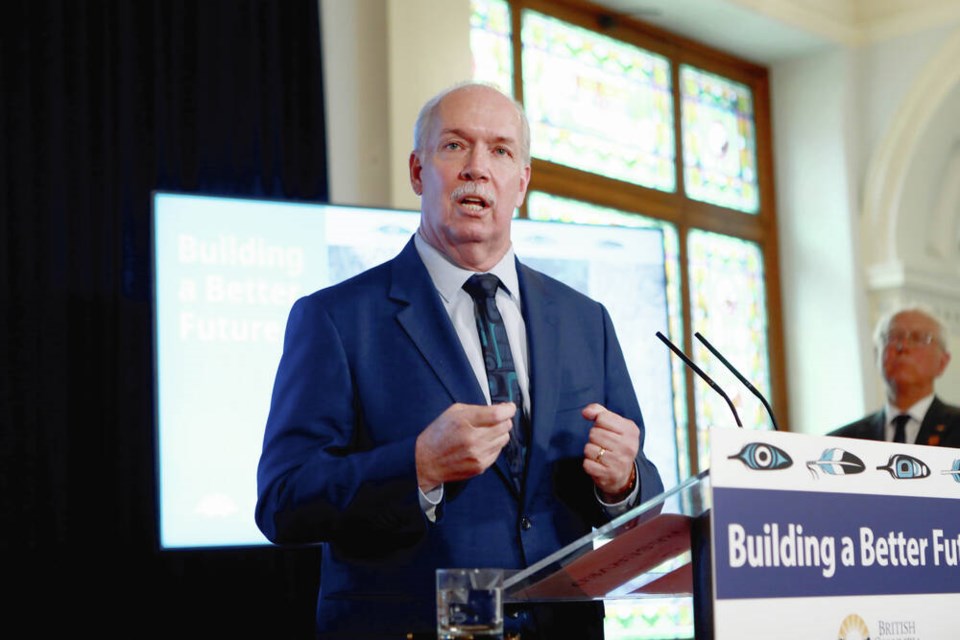The canoe metaphor is one of Premier John Horgan’s favourites when it comes to talking about Indigenous relations and reconciliation, so he used it again Wednesday while announcing a major step in that sphere.
“Sometimes, we’re not all in the same canoe,” he said while outlining a comprehensive reconciliation action plan. “But we’re all paddling together.”
And later: “Today is the day we begin to journey together and are all paddling in the same direction. Hopefully over time we’ll be in the same canoe.”
But his government is paddling in two opposing directions at the moment. For all the determination to work toward the inspiring goal of reconciliation, the NDP government is in B.C. Supreme Court right now fighting a small north Island First Nation’s title claim at every turn.
Contesting the case is the opposite of everything the new action plan purports to work toward. That might be why there’s a specific phrase in the new action plan that could be used to bridge the big gulf between what the government is saying and what it is doing.
The action plan is described as the first of its kind in the world. It commits to 89 steps to be undertaken in the next five years that would bake B.C.’s earlier recognition of indigenous rights into virtually every aspect of governance.
Part of it says B.C. “recognizes the need to shift from patterns of litigation and expensive slow negotiations about title and rights, to co-operative implementation through effective government-to-government relationships.”
It was roundly applauded by all parties in the legislature and by First Nations leaders who were invited to speak to it. But in a Vancouver court room the government is following the old pattern to the letter. The Nuchatlaht First Nation and the government are booked into B.C. Supreme Court for the next several weeks to argue over the tiny band’s claim to 200 square kilometres of Nootka Island.
As Judy Lavoie reported at the Narwhal news site earlier, the Nuchatlaht are using the precedent from the Tsilhqot’in title decision eight years ago to press their case. B.C. is contesting virtually every aspect of their claim, based on historic records about whether the Nuchatlaht was a true First Nation, how extensively the people occupied the territory two centuries ago and whether they abandoned it, along with their rights.
Asked about the disparity Wednesday, Horgan said: “It speaks to the diverse nature of British Columbia, Indigenous and non-Indigenous. We’re not always going to agree.”
Courts are the last recourse, he said, and his government has “countless” experiences of avoiding litigation by negotiating and reconciling.
The Nuchatlaht case is one that he couldn’t resolve outside of court, he said.
“But the direction to litigate, which is not provided by cabinet, it’s provided by the attorney general … questions about their strategies you should take it up with him.”
Answers are unlikely, as attorneys general can’t normally comment on active cases.
But there’s a hint of what might lie ahead in the action plan. One of the 14 steps to recognize Indigenous rights and title that the government has just committed to following is this: “Issue guidelines from the Attorney General to the Ministry of Attorney General legal counsel regarding the conduct of civil litigation involving the rights of Indigenous peoples.”
Given the tone and the stress on the historic nature of Wednesday’s action plan announcement, Attorney General David Eby is unlikely to tell his legal team to fight this one to the bitter end.
Another intriguing aspect of the action plan is what’s called the “distinctions-based approach.”
It is constantly reinforced that “Indigenous” doesn’t mean one group, it describes one characteristic that over 200 unique First Nations share. So B.C.’s action plan will acknowledge rights, interests and priorities of each one individually.
“Not all rights are uniform or the same among or between all Indigenous peoples. In many cases, a distinctions-based approach may require that B.C.’s relationship and engagement with First Nations, Metis and Inuit peoples include different approaches or actions and result in different outcomes.”
It’s a respectful approach, but it further undercuts the one canoe analogy. It is going to take some time for people to wrap their minds around.



